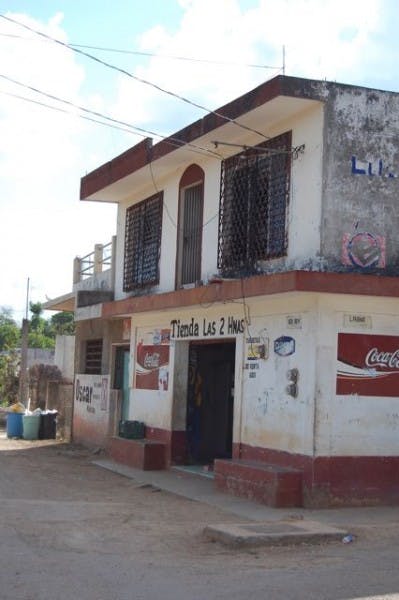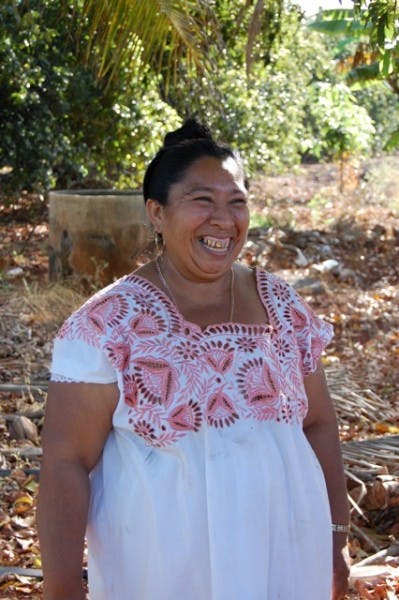It is no coincidence and a total coincidence that 20 of the kitchen staff members at Tacolicious are from the Yucatán. Some of these guys grew up 30 minutes away from each other but they’d never met until they started working at the restaurant. This includes Noe Arcángel, our sous chef.
San Francisco’s kitchens are largely staffed by people from this tropical region of Mexico but all I’ve known of it until now are the white sand beaches that most tourists find themselves having a hard time leaving.
But this time, when Joe and I flew into Cancun on Saturday for a week long trip, Joe had another kind of R&D in mind. He wanted to look up the families of the Tacolicious kitchen staff. I’m not sure you can really know someone until you see where they come from. And yesterday was a real revelation.
First thing in the morning, Joe and I left our beautiful beach hotel located near Playa del Carmen, got in our rental car and headed in a very round about way towards Merida, the colonial city which lies on the northwest side of the peninsula. Our goal for the day was to find Noe’s family who lives in a teeny tiny village called Emiliano Zapata “Coopertivo” outside of Oxkutzcab, a town of about 20,000 dating back to Columbian times. The Mayan language—which all of the Tacolicious staff speak (and Telmo’s learning, but so far he just knows the bad words)—with all its tongue-twisting Xs reminds me of being in Basque country. It makes me feel extra stupid when reading a map.
Noe came to Tacolicious via Telmo. The two worked at Tropisueño together. It’s not wrong to say that Noe, who’s 23 now, runs the daily operations of the kitchen. Yes, he’s young for such responsibility, but that’s not as crazy to me as the fact that Noe left his family when he was 18 to come to a country and place so different than his own. And his story is not atypical.
As we drove through deep green thickets of jungle, the nicely paved roads were only only punctuated by villages populated with stucco houses painted garish, yet perfect, colors of mint green and mustard yellow and cotton-candy pink, mixed with the traditional Mayan thatched roof houses. People turned to check out the two gringos rolling through town. I kept thinking, what if I were dropped off here to just find a job, learn Spanish and find a place to live? And I’m 40. This is the kind of perspective you get on the way to meet someone’s family.
Joe and I continued on through more pristine, picturesque towns such as Tzucacab and Tekax. Finally, the pure jungle opened up to some hills, a few bony cows and tethered goats and wild tamarind trees. The air was perfumed with the smell of something like honeysuckle and I kept rolling down the windows to get a whiff. The roads got smaller and smaller, and after only a few wrong turns (Joe is an excellent navigator—if it had been up to me, I would have had to find work in Mexico because I would never have found my way out of it), we found the sign we’d been looking for: “Cooperativo.”
Noe had given Joe the instructions to find his town of Emilinao Zapata “Cooperativo.” He said once we were there to simply ask anyone to point us to where his parents Carmen and Angeles live. Sure enough, Joe inquired in his broken Spanish, and a couple young girls pointed us to a two-story red and white home sitting above a mini super—one of the many all-purpose grocery stores you see in every town.
Though we hadn’t called ahead, there was Saray, Noe’s sister, plus his brother-in-law Gualberto who used to work in San Francisco as a cook at Q restaurant on Clement Street (which meant, luckily for us, his English was perfect).
This is where the story gets better because Gualberto, Saray and their five-year-old daughter let us pile in their pickup to drive out to see Noe’s mother, Carmen, who was working at their small orchard, located down bumpy dirt roads.
This was a revelation to Joe. He didn’t know that Noe comes from a family of farmers. That they have limes, avocados, oranges, bananas and more, growing in dirt that’s brick red in field much more rangey and wild than anything you’d see in the US. He also didn’t know that Noe has sent back money to his family to build the aquaduct that waters these trees, as his family proudly pointed out. When we got out of the truck to say hi, Noe’s mom, wearing the traditional huipil, greeted us all smiles and warmth, the gold on her teeth flashing in that hot sun. They told us that they’ve had a hard time this year with the lower number of tourists visiting the Cancun resorts, which is where some of their produce ends up. Noe’s mother told us how much she misses him.
After a tour, and the gift of a shiny avocado called an Especial (a cross with a Hass), we went back to their home to say our goodbyes. At the last minute, Gualberto remembered to show us his family’s other operation: a little tortilleria. He opened up a door to show us the family’s tortilla maker, a bucket of masa sitting on the floor in a room lined with beautiful, worn tiles that are all over this area. Tiles I think we might want to steal for our new tequila bar Mosto.

Noe's father Angeles, his sister Saray, his mother Carmen, his niece, and his brother-in-law Gualberto
We’ve had a nice day in Merida today, but we’ve been thinking a lot about yesterday, the little glimmer of Noe’s life we got to see, something you don’t get to do when you’re just being a tourist. Tomorrow, we’re headed to visit Juanito, Victor and Jorge’s families, who all live about an hour from here. We peaked at some of the things Juanito gave us to give his family and it made us smile to see that it includes some Tacolicious t-shirts.







